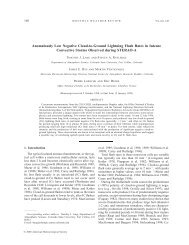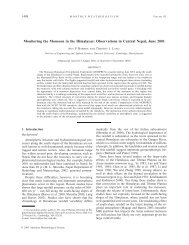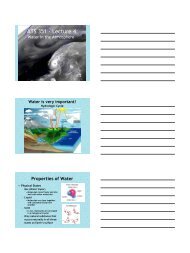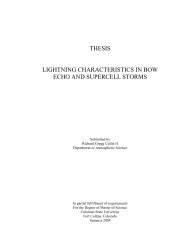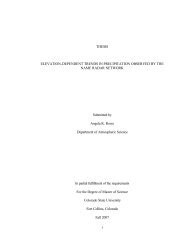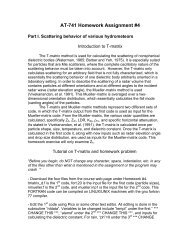1 A dual-polarization radar hydrometeor classification algorithm for ...
1 A dual-polarization radar hydrometeor classification algorithm for ...
1 A dual-polarization radar hydrometeor classification algorithm for ...
Create successful ePaper yourself
Turn your PDF publications into a flip-book with our unique Google optimized e-Paper software.
8081828384858687888990919293949596979899100101102systems such as ASOS or METAR, rapidly disseminated model output, and upper-air soundingscannot independently discern different snow crystal types, rain, freezing rain, or sleet with muchconfidence <strong>for</strong> several reasons (Elmore et al. 2011, Schuur et al. 2012). These observationalmethods do not provide the temporal or spatial resolution available from <strong>radar</strong> either.Hydrometeor <strong>classification</strong> <strong>algorithm</strong>s combining atmospheric soundings withpolarimetric <strong>radar</strong> observations have been successful <strong>for</strong> warm-season, convective precipitation(Liu and Chandrasekar 2000, Zrnic et al. 2001, Ryzhkov et al. 2005a, Dolan and Rutledgehence<strong>for</strong>thDR09, Park et. al 2009, Chandrasekar et al. 2011) because the freezing level does notvary much in space or time. This is not the case <strong>for</strong> winter precipitation though, which motivatesuse of a polarimetric <strong>radar</strong>-based melting layer detection <strong>algorithm</strong> to identify wet or meltingsnow and then in<strong>for</strong>m additional <strong>classification</strong> steps below and above this <strong>radar</strong> bright band layer(Giangrande et al. 2008 and Boodoo et al. 2010 - hence<strong>for</strong>th G8B1).To date, wintertime polarimetric <strong>algorithm</strong>s using this melting layer detection techniqueand external temperature in<strong>for</strong>mation from either a sounding or model <strong>for</strong>ecast have attempted toidentify winter <strong>hydrometeor</strong> types with varying levels of success (Kouketsu and Uyeda 2010,Elmore et al. 2011, Schuur et al. 2012). Elmore et al. (2011) showed that the <strong>radar</strong>’s inability toidentify the refreezing of raindrops and errors in the melting layer detection <strong>algorithm</strong> led toHCA failures and poor overall per<strong>for</strong>mance in diagnosing surface weather conditions. Schuur etal. (2012) produced satisfactory results using an <strong>algorithm</strong> based on rapidly updated modeloutput temperature and moisture fields along with polarimetric <strong>radar</strong> data. The methodologypresented in Schuur et al. (2012) is particularly valuable at far ranges where the <strong>radar</strong> resolutionis degraded, and below the lowest elevation angle scan where surface weather conditions cannotbe diagnosed by the <strong>radar</strong> at all.5



